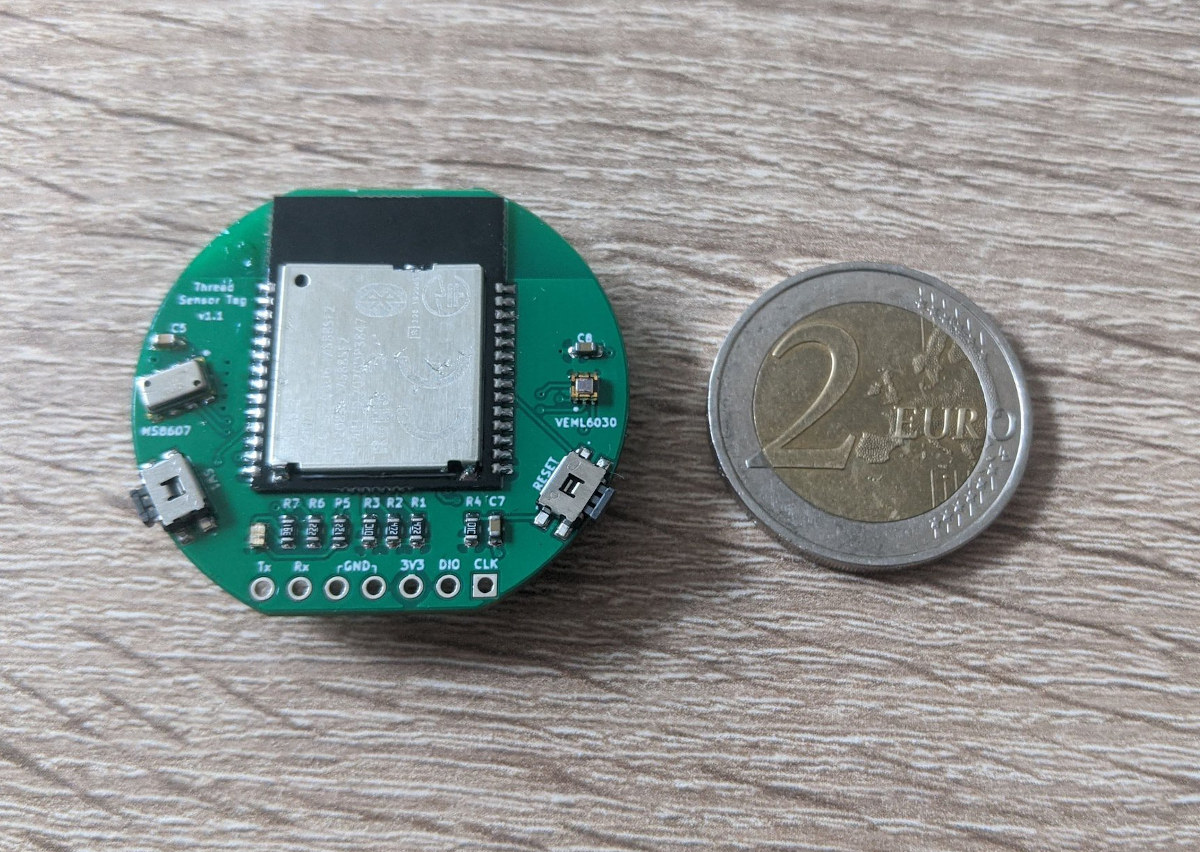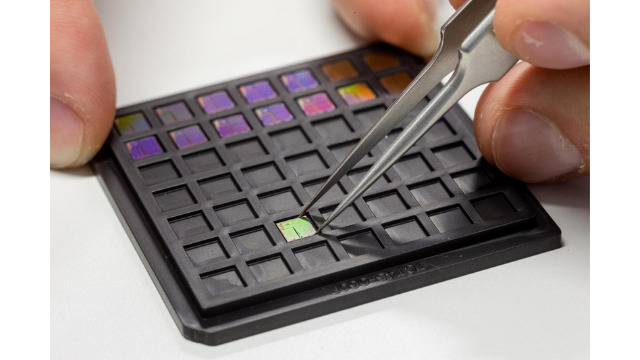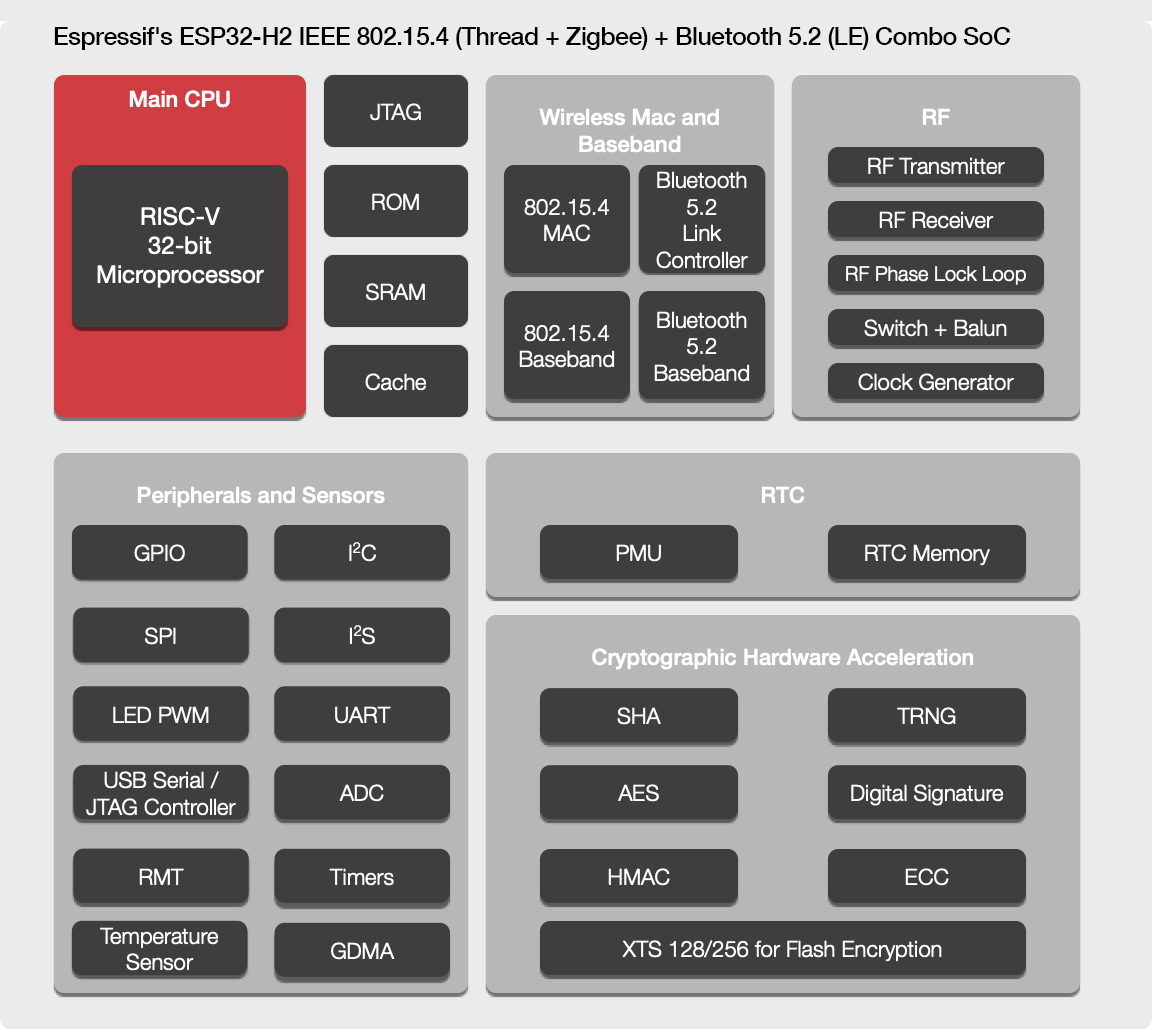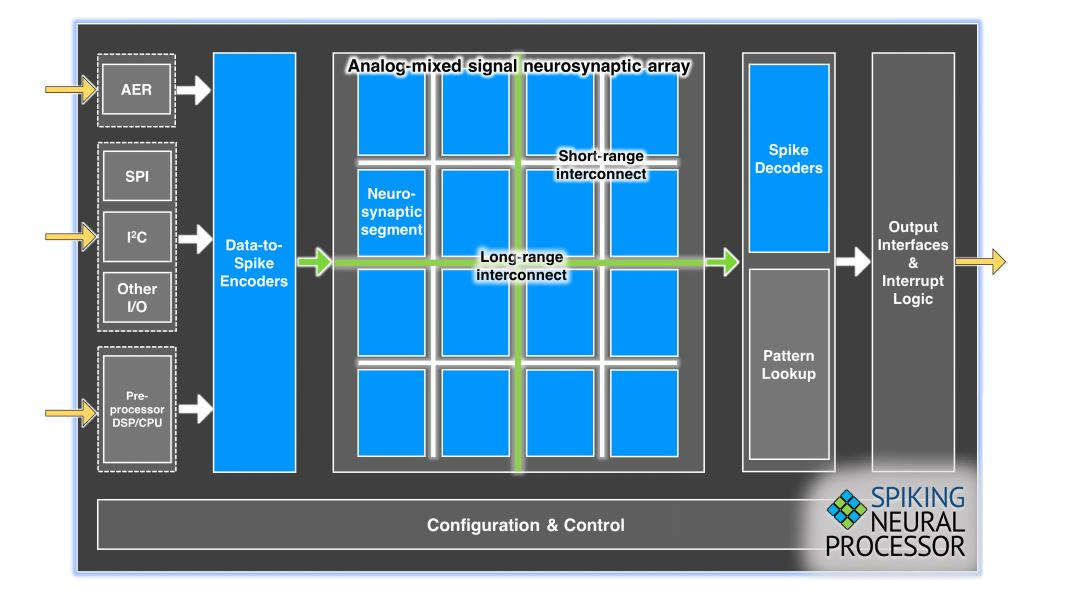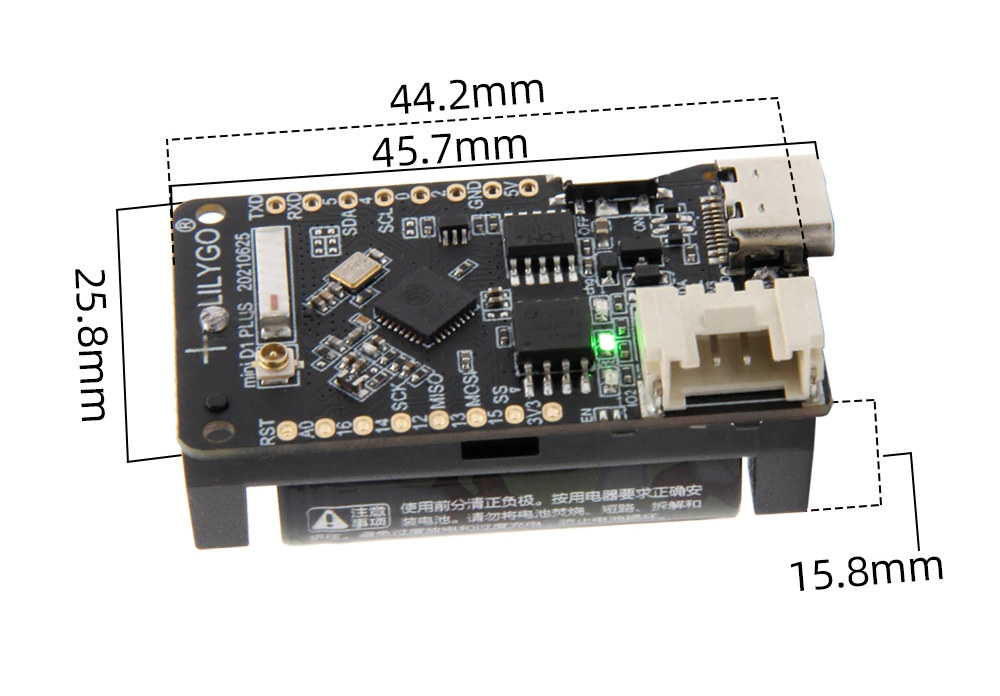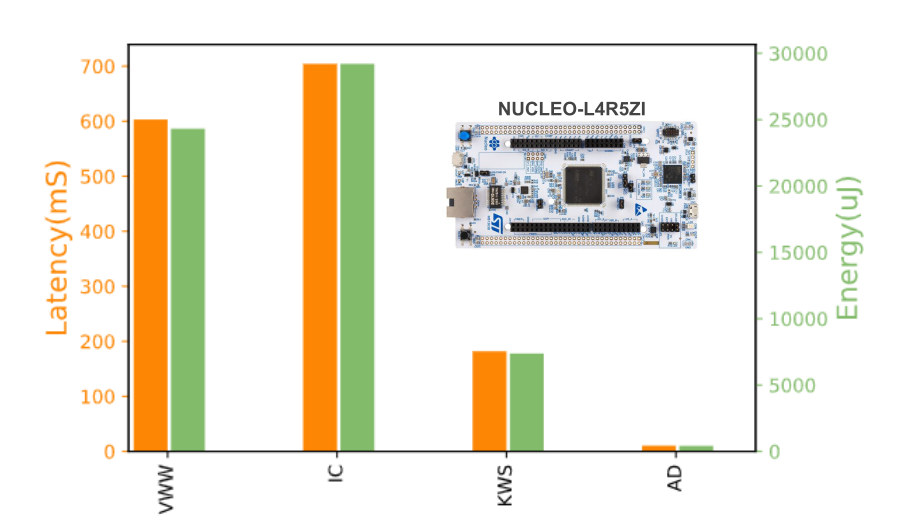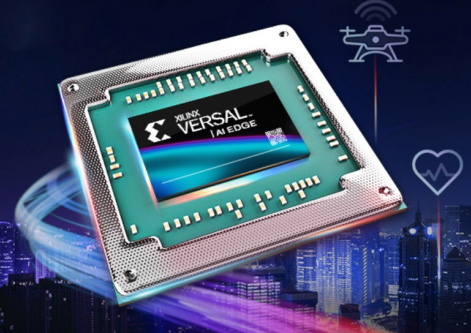Monkey Store’s Thread Sensor Tag is a pressure, humidity, temperature, and light sensor that connects to the OpenThread network, and is capable of transmitting MQTT/UDP data every 20 seconds over a period of around three years from a single coin cell battery. As a reminder, OpenThread is an implementation of the Thread IoT network protocol that was unveiled in 2016 by Nest Labs (now Google/Alphabet). This has not been widely used so far, but we did write about MKR SharkyPro development board with OpenThread support via STMicro STM32WB5MMG wireless module earlier this year, and Monkey Store is telling us both Google and Apple are working on devices with support for the IoT protocol. Thread Sensor Tag specifications: Wireless module – Minew MS88SF2 based on Nordic Semi nRF52840 multi-protocol 2.4GHz wireless Cortex-M4 microcontroller Sensor VEMLS6030 I2C light sensor MS8607 pressure, humidity, and temperature sensor I/Os – 7x through holes with Tx/Rx, […]
Ultra-Low-Power RISC-V System-on-Chip features Adaptive Body Biasing Technology
CSEM and USJC together have developed an ultra-low-power RISC-V chip for electronic gadgets such as wearables. The semiconductor companies, from Switzerland and Japan respectively, have been in the market for a while, developing technologies for low-power chips. Their latest collaboration uses Adaptive Body Biasing (ABB) and Deeply Depleted Channel (DDC) to build an ultra-low-power RISC-V chip with all the required and necessary components. Originating from the labs of CSEM, the Adaptive Body Biasing dwells into the operating efficiency of all the modes of ON, Standby, and OFF. There has been the problem of power leakage in Standby and OFF operating modes, but the Adaptive Body Biasing technology helps design to minimize power leakage when the processor is not operating while keeping the best performance in ON mode. For most of the designs, the processor is in Standby mode waiting for the incoming data or the next event to be offered. […]
Bluetooth 5.3 new features lower latency, interference, improve battery life, security
Bluetooth 5.3 Core Specification was adopted on July 13, 2021, without fanfare, and the only related announcement that I could find is CEVA RivieraWaves Bluetooth IP getting support for Bluetooth 5.3. Bluetooth 5.3 brings four new features or enhancements and removes one extension from the core specification: Periodic Advertising Enhancement – The AdvDataInfo (ADI) field of the common extended advertising payload format may now be included in AUX_SYNC_IND protocol data units (PDUs) which are broadcast when a device is performing periodic advertising. The Bluetooth Low Energy (LE) controllers may now use the information in the ADI field to recognize packets that contain retransmitted copies of identical or semantically equivalent data, and discard those packets in order to prevent unnecessary processing on the nodes, and make sure the overall throughput is not affected due to retransmitted packets. Encryption Key Size Control Enhancement – In Bluetooth BR/EDR, encryption key sizes are negotiated […]
ESP32-H2 RISC-V WiSoC announced with Zigbee 3, Thread, and Bluetooth LE 5.2
Just a few days ago, we noted ESP32-H2 802.15.4 & BLE RISC-V SoC had shown up in the source code, and tried to derive specs and a block diagram from the info seeing it was similar to ESP32-C3, but swapping the WiFi radio for an 802.15.4 radio. We don’t need to guess anymore, as Espressif Systems has just announced ESP32-H2 RISC-V WiSoC with support for Zigbee 3.x, Thread 1.x through the 802.15.4 radio, as well as Bluetooth LE 5.2. So overall it’s very close to what we discussed from the information in the source code with ESP32-H2 highlights including: CPU – 32-bit RISC-V core (at up to 96 MHz) RAM – 256 KB SRAM Storage – External flash support Wireless connectivity IEEE 802.15.4 radio with Zigbee 3.x and Thread 1.x support, Matter protocol Bluetooth 5.2 (LE) radio designed in-house, with support for direct connection, Bluetooth Mesh, Bluetooth LE Audio Future […]
Innatera neuromorphic AI accelerator for spiking neural networks (SNN) enables sub-mW AI inference
Most AI accelerators currently rely on CNN (convolutional neural network) to perform AI inference in a much faster and efficient way than on CPU cores, or even GPUs. But there’s another type of neural network, namely spiking neural networks (SNN) that uses the timing of spikes in an electrical signal to perform pattern recognition tasks in a way similar to neurons in the brain. The claims in terms of efficiency are quite unbelievable, with up to 10,000 times more performance per watts than in microprocessor and digital accelerometer, 500 times lower energy, and 100 times shorter latency. Several companies are working on neuromorphic AI accelerators for spiking neural networks, with notably Prophesee focusing on image processing, and Innatera that is working on an ultra-low-power AI accelerator handling audio, health, and radar for sound and speech recognition, vital signs monitoring, elderly person fall sensors, etc… Innatera recently provided additional information about […]
ESP32-C3 board comes with 16340 battery holder, D1 mini compatibility
It looks like ESP32-C3 floodgates have opened. We’ve just written about several NodeMCU ESP32-C3 boards, and now there’s another board with the RISC-V WiFI & Bluetooth processor. Meet LilyGo TTGO T-OI PLUS equipped with a 16340 battery holder. Getting a battery-powered ESP32-C3 board could prove to be very interesting as ESP32-C3 power consumption is much lower than ESP8266 and ESP32, notably in deep sleep mode, where the RISC-V processor consumes just 5uA, against 20 uA for ESP8266 and ESP32, and the difference is even greater in light sleep mode (ESP8266: 2000 uA vs ESP32-C3: 130 uA). LilyGo TTGO T-OI PLUS specifications: SoC – Espressif Systems ESP32-C3 single-core RISC-V processor @ 160 MHz with 2.4 GHz WiFi, Bluetooth 5.0 LE Storage – TBD flash (probably 2MB or 4MB) Antenna – Ceramic antenna and IPEX connector USB – USB-C port for power and programming Expansion 2x 8-pin headers with 12x GPIO, 1x […]
Benchmarking TinyML with MLPerf Tiny Inference Benchmark
As machine learning moves to microcontrollers, something referred to as TinyML, new tools are needed to compare different solutions. We’ve previously posted some Tensorflow Lite for Microcontroller benchmarks (for single board computers), but a benchmarking tool specifically designed for AI inference on resources-constrained embedded systems could prove to be useful for consistent results and cover a wider range of use cases. That’s exactly what MLCommons, an open engineering consortium, has done with MLPerf Tiny Inference benchmarks designed to measure how quickly a trained neural network can process new data for tiny, low-power devices, and it also includes an optional power measurement option. MLPerf Tiny v0.5, the first inference benchmark suite designed for embedded systems from the organization, consists of four benchmarks: Keyword Spotting – Small vocabulary keyword spotting using DS-CNN model. Typically used in smart earbuds and virtual assistants. Visual Wake Words – Binary image classification using MobileNet. In-home security […]
Xilinx announces Versal AI Edge Series with Cortex-A72 & R5 cores, FPGA fabric
Edge AI solves the latency and security issues through on-device AI acceleration for optimal computations at a low power supply. Xilinx announces its Versal AI Edge Series which is 4th member of the Adaptive Compute Acceleration Platform (ACAP) family. The versal series consists of seven models ranging from VE2002 to VE2802 with the processor fabrication on 7 nm silicon technology. Talking more about ACAP, it is a platform that provides a combined essence of a processor and FPGA. The processing features efficient memory and I/Os, whereas programmable arrays allow logical control over the hardware. Also, as Xilinx specializes in FPGA products, the additional support of computational features makes the ACAP hardware even more flexible and dynamic. The Versal AI Edge series features different types of engines for specific functionalities in terms of adaptable, scalar, and intelligent engines. The seven processor models vary with respect to engine and platform specifications. However, […]


